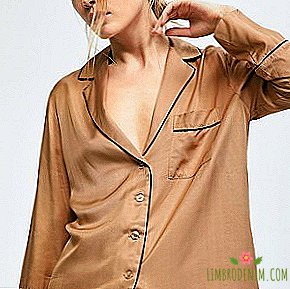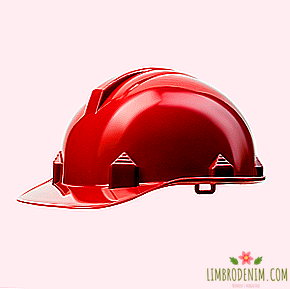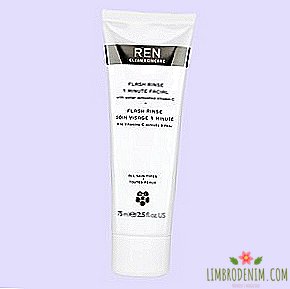One hundred years of make-up: How to repeat make-up of different decades
Over the past hundred years - almost a minute on the scale of eternity - not only the ideas about human rights, fashion, but also the representation of women's images in popular culture and the whole concept of beauty have changed completely. On the ideas of what is fashionable and what is not, everything affects - from the political and economic state of the country to images that broadcast film and pop stars.
The project 100 Years of Beauty, focusing on images replicated in pop culture, clearly demonstrates how these ideas have changed in different countries. Changed makeup, hairstyle and style - along with music, literature, political system and, not least, the place of women in society. Moore Soboleva tried to bring together the styles that are popular in makeup in each decade, and picked up the tools that will help them recreate. We focused primarily on the European-American model - it is clear that in the countries of Asia and Africa both the images and styles were different, and this is a completely different conversation.
1910s

The decade that contained the end of the Edwardian Era and the First World War. Silent cinema, theater and ballet influence ideas about female beauty: ballerina Anna Pavlova and actress Mary Pickford are considered ideal. In 1909, Harry Gordon Selfridge opens a Selfridges store in London with the first “cosmetic corners” and comes up with a new marketing pitch: shopping is not a necessity, but a pleasure.
In fashion - aristocratic pallor (tan at this time is still considered the lot of the poor, many working in the fresh air) and clearly decorated eyebrows. A sign of health is considered to be pink blush all over the cheek: this is what we see on postcards and posters, with him Mary Pickford appears on the cover of The Theater magazine. Eyes are painted to a minimum: only actresses who are strictly enslaved to the image of a vamp woman, in particular Ted Bara, actively use black shadows. On the whole, cosmetics are the prerogative of rich people and "idle" women: they started cheaming for make-up then!
1920s

On August 19, 1920, the Nineteenth Amendment to the US Constitution was adopted, which gave women the right to vote. The “roaring twenties” began, one of the brightest decades in history. The heyday of jazz, literature and the general feeling of freedom gave rise to the concept of flappers: girls who, like men, participated in public life and enjoyed themselves along with them.
Flappers wore short dresses, cut their hair, smoked, sang, danced, led active sexual lives and brightly painted. Zelda Fitzgerald, Isadora Duncan, Louise Brooks, Clara Bow - bright women become important figures in cultural life. Classic flapper makeup - thin bright eyebrows (they were often shaved and painted again over the eyebrows), dramatic black smokes, dark thin clear lips with a pronounced "Cupid's bow" and sometimes made up with a "heart".
1930s

America has sunk into the Great Depression, and Europe, barely recovering from the shocks of the First World War, is preparing for the Second. The flapper boom is fading away, the jazz era is ending. The frivolity is replaced by the powerful charisma of strong and not particularly cheerful women: Katherine Hepburn, Bette Davis, Joan Crawford, Marlene Dietrich in a man's suit. Greta Garbo, whose career flourished in the late 20s, is famous for the fact that she almost never smiles on the screen (the film “Ninochka” in 1939 comes out with a tagline “Garbo laughs!”). There are legends about their complex characters, their personal life is a subject of discussion.
These new complex women have clearly defined lips and dramatic cheekbones beyond the boundaries of the natural line. Eyes emphasize long curved eyelashes. The actresses use invoices, but the industry does not lag behind: in 1931, the first curler for eyelashes went on the market, and in 1933, Maybelline produced inexpensive mascara, available to anyone.
1940s

War-torn world calls on women: they become full participants in terrible events. There are propaganda posters showing the potential of female power: one of them, "We Can Do It!", Was later replicated as feminist. His heroine has his hair tucked under a handkerchief, on his face a healthy tan and blush. At the same time, the image of a pin up girl with long hair, rounded shapes and bright (usually coral-red) lips is gaining in popularity.
A pin-up girl is usually half-naked or dressed in military uniform: a woman, despite all calls for work, should still inspire men in the public view. Pin-up posters are common among soldiers; they often feature film actresses - in particular, Betty Grable and ultra-popular Rita Hayworth (one of the first atomic bombs was named Gilda after her heroine in the film of the same name). In the cinema, noir is becoming an important genre - a detective implicated in vices, where often there is not a single positive hero and the fatal woman is obligatory.
1950s

Post-war time takes away the initiative of women and returns them to the kitchen, to her husband and children. The baby boom begins, and the problem image of the “ideal housewife” comes into fashion - with a neat haircut, heels, makeup and jewelry, preparing a multi-course meal and managing to take care of the house and garden.
The famous material "The Good Wife's Guide", published in the magazine Housekeeping Monthly in May 1955, contains a complete list of the rules of the "good wife", and even if this text is specifically fake, as some skeptics claim, it is still quite indicative. A beautiful woman of the 50s is a well-groomed and healthy woman: she has perfect red lipstick, even wide eyebrows, underlined cheekbones and hair. Both in life and on screen she should be traditionally sexy and sweet, a little naive and at the same time see her happiness in a man - as the heroine Marilyn Monroe and Audrey Hepburn.
1960s

Sugar Pentecostal crust, fortunately, was quickly cracked: the next decade brought the sexual revolution (primarily due to the onset of birth control pills in 1960), and with it the so-called British invasion - the flowering of British countercultural art, which was led by The Beatles. In the States, Andy Warhol founds the "Factory", which becomes not so much an art studio as a way of life.
Women shortly cut their hair and draw huge eyelashes like Twiggy, or emphasize sexuality built into an absolute: deliberately like Brigitte Bardot and relaxed like Jane Birkin and hippies. At the same time, under the sign of space exploration, futurism, gloss and plastic come into fashion, but the "space" fashion remains conventional sexually. In the make-up, women begin to master the bright pastel shades and the cut crease technique (tightly traced folds of the century), which will return to instagram fifty years later.
1970s

The aesthetic and cultural upheavals of the 60s set several important trends that flowed into the 70s. Hippies spawned a fashion for naturalness and "natural tones" - Yoko Ono's long hair and face without makeup became symbols of the aesthetics of the early 70s. Thanks to them, an interest in psychedelics, bright shadows and ethnic motives arose in society.
The sexual revolution, inseparably linked with the hippie, and the principles of free love continue to liberate women — Debbie Harry and Farrah Fawcett appear on the covers, beautiful, bold and made-up. At the same time in New York, and later in London, glam and punk movement is gaining momentum - and with it, the extreme black arrows of the sample of Suzy Sue. Make-up ceases to be a purely female prerogative (proof of this is glitter on the faces of the soloists of the New York Dolls), and thanks to David Bowie, androgynous images come into fashion.
1980s

The years of unbridled are coming, another word cannot be found, disco: leopard prints, huge hairs, a shimmer and a large glitter of all possible colors, rhinestones and sparkles with a five-kopeck coin in size crawl into the light.
The decade, which was recently made to despise, extremely expanded the boundaries of style, proclaiming the principle "the brighter - the better." In 1981, the MTV channel opens, and the street singer’s fashion (Cindy Loper, Kim Wilde) is influenced almost more than the film actress - but even style icons such as Michelle Pfeiffer are not outdated by the 80s cheerless fashion. Star Wars and Back to the Future franchises open the era of blockbusters - cinema is now more focused on young people than on adults; at the same time begins the boom of teen serials.
1990s

The color boom of the 80s is replaced by minimalism on the one hand and an aggressive grunge on the other: the heroic chic of young Kate Moss and the fragility of Winona Ryder side by side with the smeared lipstick of Courtney Love and brown puffy lips of Shirley Manson from Garbage. At the same time, the style is dictated by the heroes and heroines of teenage films - in the States the name of the film “Stupid” is still breathy, and the owner of Lime Crime Do Deer even dedicated a collection to him.
In the underground fashion at the peak of the rave aesthetics with its bright colors, and in the glossy - the supermodel boom: the names of Naomi, Cindy, Claudia and Linda do not require names, and George Michael’s clip "Freedom!" sets new (and rather unrealistic) standards of beauty and sexuality.
2000s

In 2003, Lancôme creative director Fred Farrugia launches Juicy Tubes - transparent thick glints with fruit smells - which instantly become objects of desire (and at the same time imitation). The 2000s inherited the minimalism of the previous decade, having developed it: during this period it is customary to paint with faint neutral shades, only to decorate them with clear black arrows, they wear the same transparent shine or peach lipstick on their lips.
Angelina Jolie, already a superstar, is styling a greige-gray lipstick (brands are beginning to diligently produce similar colors), broken eyebrows and pale skin. On the other hand, interest in Latin American stars - Jennifer Lopez, Salme Hayek - popularizes tanning: tanning beds and tanning products compete with powders and napkins.
2010s

Our time is usually characterized as the most diverse: the cosmetic industry offers all possible colors and textures. The desires of customers and, accordingly, manufacturers finally coincided with the possibilities: the formulas make it possible to achieve both bright colors and non-dry textures, durability and comfort.
Make-up becomes art and finally ceases to fit into the boundaries of gender: Patrick Starrr and Manny Gutierrez play no less a role in the cosmetic fashion than Kim Kardashian. Traditional colors are boring to everyone, and users are learning new shades: red shadows have become a daily trend, and even the lips of non-natural colors will surprise no one. The instagram is dominated by long arrows, active contouring, wet, radiant cheekbones, and perfectly shaped lips (even if they are blue).
In parallel with instamazykuyu, involving ten layers of cosmetics (simply because the camera "eats" half of the colors and textures), the fashion for "natural beauty" develops - and glossy (notorious "healthy shine", healthy glow), and un-retouched: women are increasingly shown as they are. Make-up from the need finally turned into an accessory, and appearance - in the medium of mood, which can be changed depending on the desire. And it is this - and not at all the variety of textures - the main achievement of the industry.
Photo: Wikimedia Commons (1, 2), Paramount Famous Lasky Corporation, Paramount Pictures, Twentieth Century Fox, Alan Clore Films, Regency Enterprises, Nikkie Tutorials




